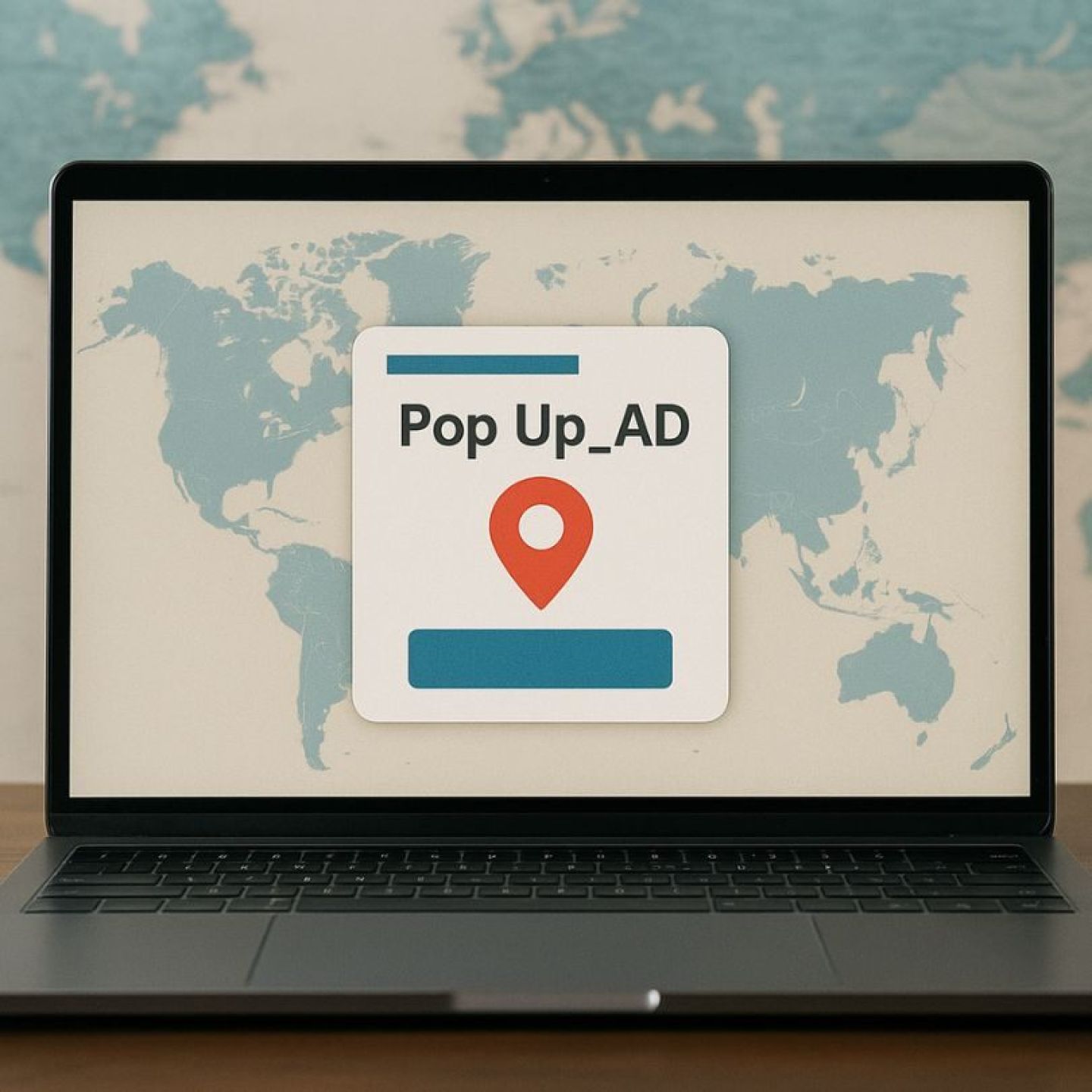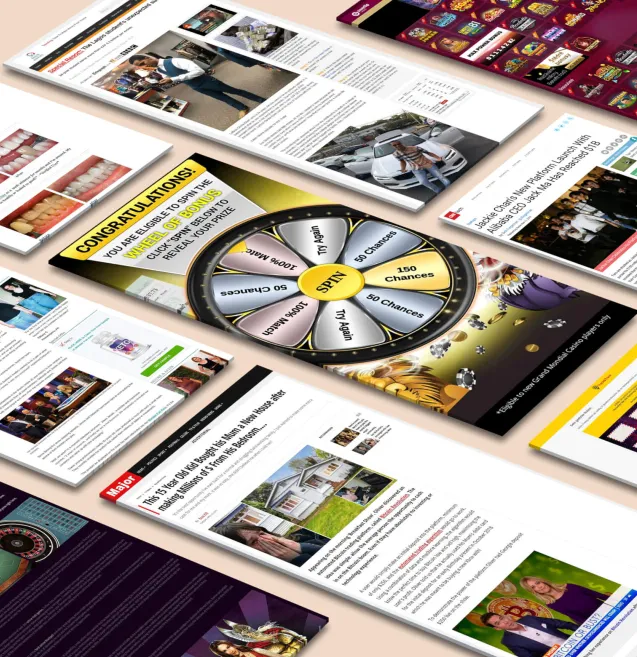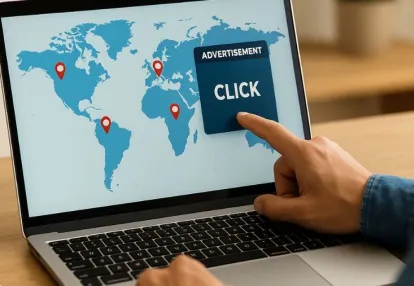
Our spy tools monitor millions of popup and pop-under from over 90+ countries and thousands of publishers.
Get StartedSmart geo-targeting for pop campaigns in 2025 represents a fundamental shift in how you connect with your audience through popup advertisements. At its core, geo targeting pop ads means delivering personalized popup messages to users based on their specific geographic location—whether that's their country, state, city, or even neighborhood.
Why does this matter? Generic, one-size-fits-all popups are dead. Users expect relevant content that speaks directly to their needs, and location plays a massive role in determining what's relevant. A visitor in New York City has different preferences, regulations, and expectations than someone browsing from rural Texas or London.
Location-based advertising 2025 has evolved beyond simple country-level targeting. You can now combine geographic data with behavioral triggers, device types, and real-time user actions to create hyper-personalized experiences. This precision transforms popup campaigns from annoying interruptions into valuable touchpoints that actually convert.
The result? Pop ad campaign optimization through smart geo-targeting delivers measurably higher engagement rates, reduced bounce rates, and conversion improvements that directly impact your bottom line.
Advanced geo-location targeting transforms how you connect with your audience through popup ads personalization. This technology allows you to segment visitors with surgical precision—from broad country-level campaigns down to specific neighborhoods within a city. You can create distinct experiences for users in Manhattan versus Brooklyn, or target shoppers in downtown Chicago differently from those in suburban areas.
The real power emerges when you layer geographic segmentation with additional data points. Combining location with device type means you can serve mobile-optimized offers to smartphone users in Los Angeles while desktop visitors in the same city see different messaging. User behavior triggers amplify this capability—imagine showing exit-intent popups with location-specific shipping promotions only to visitors who've spent more than two minutes browsing your product pages.
Smart location-based advertising relies heavily on dynamic smart tags that automatically populate visitor information. These tags pull data like {city}, {state}, or {country} directly into your popup copy, creating messages that feel personally crafted. A visitor from Austin sees "Special offer for Austin residents!" while someone from Seattle receives "Exclusive Seattle discount inside!"
This multi-dimensional approach to location targeting in digital ads creates campaigns that feel less like generic advertisements and more like personalized recommendations. You're speaking directly to your visitor's context, addressing their specific geographic needs and preferences in real-time.
To fully leverage the potential of this strategy, consider exploring the secrets of pop ads which can provide valuable insights into massively scalable pop advertising, a crucial aspect of successful geo-targeted campaigns.
Exit-intent popups capture visitors at the precise moment they're about to abandon your site. When you combine this trigger with geographic data, you can present location-specific offers—like free shipping to specific regions or local store discounts—right when users need that final push to convert. I've seen conversion rates jump by 30-40% when businesses tailor their exit offers based on where visitors are browsing from.
Scroll-triggered popups activate after users engage with a certain percentage of your content. You can set these to appear at different scroll depths depending on the region. For instance, visitors from high-intent markets might see offers at 50% scroll depth, while those from newer markets receive educational content at 75% scroll.
Interactive geo-targeted popups transform passive interruptions into engaging experiences. Quizzes that ask "Which [Your City] location is closest to you?" or "What's your biggest challenge in [Region]?" create personalized pathways based on responses. These interactive elements generate 2-3x higher engagement rates compared to static popups.
The key to selecting the right trigger lies in understanding your audience's behavior patterns by location. Time-delayed popups work better for regions with longer browsing sessions, while immediate welcome popups convert well in markets where users prefer quick decisions. Test different combinations of triggers with your geographic segments to identify what resonates with each audience.
Smart Geo-Targeting for Pop Campaigns in 2025 delivers measurable business results that directly impact your bottom line. When you implement location-based popups, you'll see a conversion rate increase ranging from 15% to 40% compared to generic campaigns. This happens because you're presenting contextually relevant offers that match what users in specific regions actually want.
You can tailor promotions based on regional preferences, seasonal variations, and local purchasing power. A visitor from New York sees different pricing than someone browsing from rural Montana. Your popup might highlight free shipping for domestic customers while emphasizing international delivery options for overseas visitors.
When users land on your site and immediately encounter content that speaks to their location, they stay longer. Bounce rate reduction of 20-30% is common when you serve localized content through geo-targeted popups. You're showing visitors you understand their needs before they even scroll.
Region-specific incentives work exceptionally well for list building. You might offer a discount code for a local event, early access to products launching in their area, or content relevant to their regional interests. This approach generates higher-quality leads because subscribers receive offers they can actually use.
Personalized communication creates memorable interactions. You're not bombarding everyone with the same message—you're treating each visitor as an individual with unique needs based on their location.
The market offers several robust popup software with geo-targeting capabilities designed to streamline location-based campaigns. Here are some notable options:
AI-powered popup tools are transforming how marketers approach geographic personalization. These platforms analyze visitor behavior patterns and automatically adjust messaging based on location data, eliminating the guesswork from campaign optimization. Here are some ways AI is influencing geo-targeting:
These AI geo targeting strategies enable you to deliver hyper-personalized experiences that feel native to each visitor's market, driving higher engagement rates across different geographic segments.
Moreover, the landscape of geo-targeting is evolving rapidly with the advent of mobile technology. A recent article highlighted the 20 best mobile geo-targeting advertising tools for your affiliate marketing campaigns in 2025. These tools are set to revolutionize the way businesses implement their marketing strategies, providing even more refined and effective methods for reaching target audiences based on their geographical location.
A/B testing geo-targeted messages separates successful campaigns from mediocre ones. You need to test different headlines, offers, and calls-to-action for each geographic segment. A discount that resonates with visitors in New York might fall flat with your Los Angeles audience. I've seen campaigns where changing a single word in the popup copy—from "deal" to "offer"—increased conversions by 23% in specific regions.
Real-time analytics dashboards give you the power to make data-driven decisions instantly. You should monitor these key metrics by location:
When you notice a particular city or region underperforming, you can immediately adjust your messaging or offer. The best popup platforms provide heat maps showing exactly where your geographic targeting hits or misses. You'll want to review this data weekly at minimum, daily for high-traffic campaigns.
AI dynamic personalization strategies in location-based advertising are reshaping how marketers approach Smart Geo-Targeting for Pop Campaigns in 2025. Machine learning algorithms now analyze geographic data patterns in real-time, automatically adjusting popup content, imagery, and offers based on regional preferences and cultural nuances. You can deploy campaigns that adapt messaging for users in Miami versus Minneapolis without manual intervention—the AI learns from conversion data and continuously refines your approach.
The integration landscape has expanded dramatically. Modern popup platforms now sync bidirectionally with CRM systems like Salesforce, HubSpot, and Zoho. This connectivity enables sophisticated lead nurturing workflows where popup captures in specific cities trigger location-aware email sequences. You can segment Chicago leads into different nurture paths than Los Angeles contacts, delivering region-specific case studies, local event invitations, and territory-based sales rep assignments.
Privacy-first targeting methods are gaining traction as third-party cookie deprecation accelerates. Contextual geo-targeting—analyzing page content and first-party location data rather than tracking cookies—provides compliant alternatives. You maintain personalization power while respecting user privacy preferences across different regulatory environments.
The future of geo-targeting pop ads is here, and you have every opportunity to take advantage of it. Smart Geo-Targeting for Pop Campaigns in 2025 isn't just another marketing buzzword—it's a proven strategy that transforms how you connect with your audience. You can deliver personalized experiences that resonate with users in their specific locations, driving conversions that generic campaigns simply can't match.
Start implementing these advanced tools today:
The technology is accessible, the results are measurable, and your competitors are already moving in this direction. You deserve to leverage the full potential of location-based marketing to create popup campaigns that truly perform.
Receive top converting landing pages in your inbox every week from us.
Tips & Tricks
Expanding your pop ad campaigns globally requires the right geo-targeting strategies. Explore five proven approaches to scaling pop ads across different regions while maintaining strong performance. Learn how to adapt creatives, timing, and messaging to match local audiences and cultural nuances. Perfect for advertisers ready to take their pop campaigns to an international level with confidence.
David Kim
7 minDec 11, 2025
How-To
Turn lost opportunities into sales with effective holiday remarketing using push ads. Learn how to re-engage shoppers who abandoned their carts through timely, personalized notifications. Discover proven strategies for crafting irresistible messages that drive action and recover revenue. Perfect for marketers aiming to boost conversions and maximize holiday season profits.
Elena Morales
7 minDec 10, 2025
How-To
AI is transforming the way advertisers approach pop campaigns in 2025. Discover how automation, predictive analytics, and real-time optimization can enhance targeting and boost engagement. Learn practical tips for creating smarter, high-performing pop ads that deliver measurable results. Perfect for marketers ready to stay ahead in the evolving world of AI-driven advertising.
Priya Kapoor
7 minDec 8, 2025




